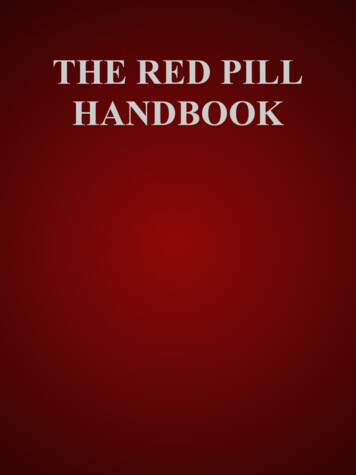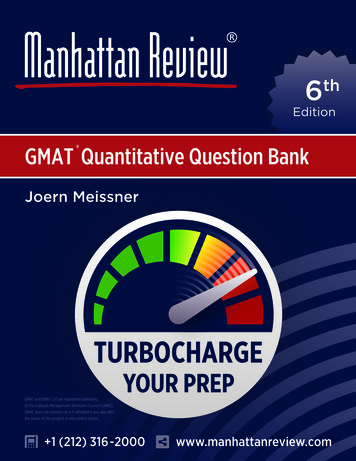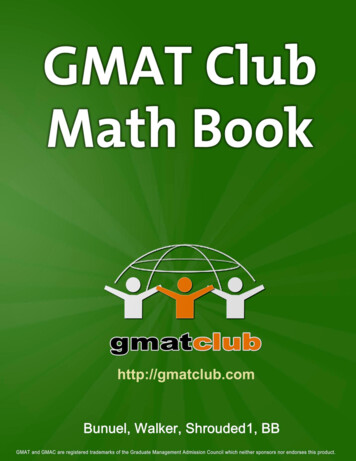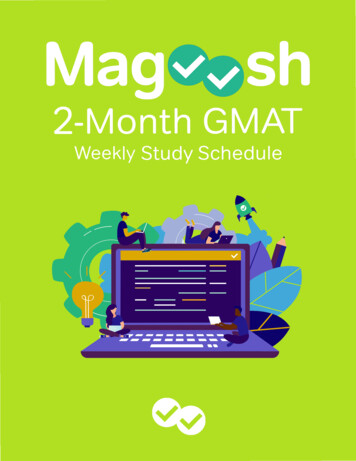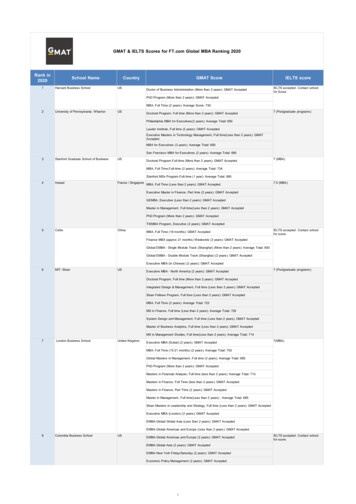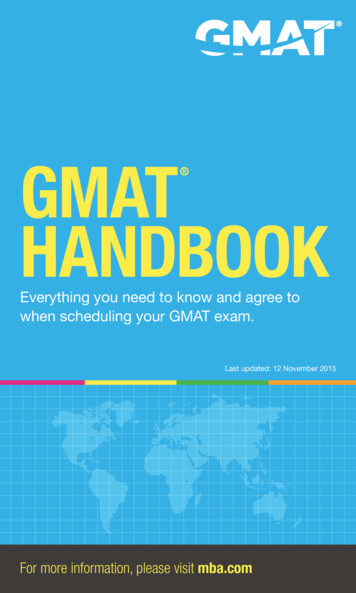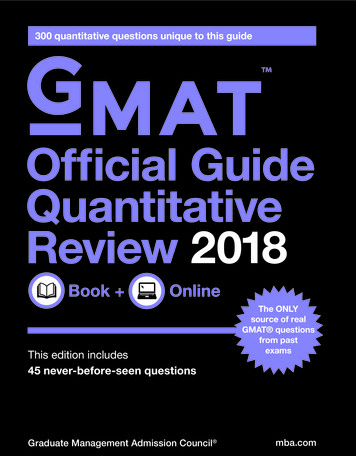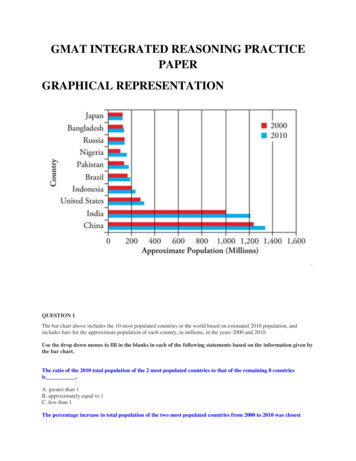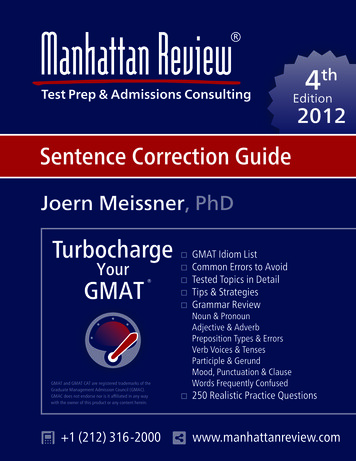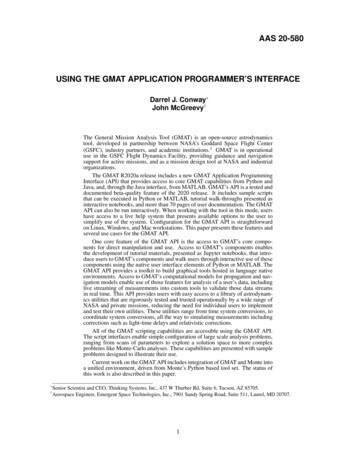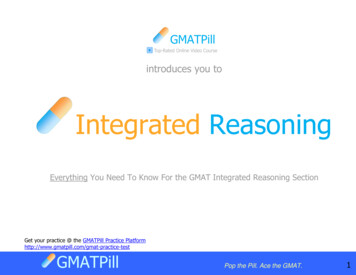
Transcription
GMATPillintroduces you toIntegrated ReasoningEverything You Need To Know For the GMAT Integrated Reasoning SectionGet your practice @ the GMATPill Practice GMATPillPop the Pill. Ace the GMAT.1
Table of ContentsIntroduction . 3About Us . 4Integrated Reasoning: What is it? . 12Key Points for Integrated Reasoning . 12Q: How does Integrated Reasoning affect your 800 score? . 12Q: Will there be a calculator for the integrated reasoning section? . 13Q: How much longer will the exam be? . 13There are 4 types of Integrated Reasoning Questions . 13Type #1 of 4: Graphics Interpretation . 14Type #2 of 4: Two-Part Analysis . 15Type #3 of 4: Table Analysis . 16Type #4 of 4: Multi-Source Reasoning . 17Integrated Reasoning Scoring . 18Additional Points for Integrated Reasoning . 20Two Part Analysis: What are the 2 Parts? . 22Two Part Analysis Sample Framework: Table Top Preview . 23Two Part Analysis Sample Framework: Imaginary 3rd Column Preview . 24Two-Part Analysis Practice Questions (5) with Video Explanations . 25Graphics Interpretation. 30Graphics Interpretation Practice Questions (5) with Video Explanations . 31Graphics Interpretation Concepts: Correlation . 36Graphics Interpretation Concepts: Slope . 37Graphics Interpretation Concepts: Units & Metrics . 38Table Analysis . 39Table Analysis Concepts: Sorting and Rank . 39Table Analysis Concepts: Mean, Median, Range . 40Table Analysis: 3 Practice Questions with Video Explanations . 41Multi Source Reasoning . 44Multi Source Reasoning: Reading Tips . 45Multi Source Reasoning: 3 Practice Questions with Video Explanations . 46GMATPillPop the Pill. Ace the GMAT.2
IntroductionLet this eBook introduce only the most important elements of the Integrated Reasoning section for the purposes of the GMATexam.The Integrated Reasoning section introduces various question types that make your brain think in unnatural ways. Part of theway to dominate the GMAT will be to get familiar with these question types using GMAT Pill’s Interactive Question Platform tostudy your GMAT with.For a more clear-cut understanding of specific integrated reasoning questions, sign up for the Integrated Reasoning Pill! Otherpills include the SC, CR, RC, DS, and PS Pills.GMATPillPop the Pill. Ace the GMAT.3
About UsGMAT Pill is a unique, thought-process video based approach to dominating the GMAT exam. Our quick andpainless approach focuses on helping you maximize your score in as little time as possible. Study less.Score More.The techniques designed by Zeke Lee, a Stanford graduate, were originally only accessible by the verywealthy who could afford tutoring rates of 250 per hour. Since Zeke released his study methods out intothe public, his techniques have gone viral. Thousands have learned the GMAT Pill Study Method and now –it’s your turn.GMAT Pill Has Been Featured in GMATPillPop the Pill. Ace the GMAT.4
Training MBA Candidates From Around the WorldA Few Unsolicited Email ReviewsSkip to other unsolicited email reviews Kelvin 780 Asian Female Wharton 740 Kang Cao 690 to 760 Brendan Brosnan Review New customer email thank you’s Oxford MBA’s experience with numerous prep providersGMATPillPop the Pill. Ace the GMAT.5
Kelvin 780Read more about Kelvin here.Asian Female Wharton 740Read more about this student (Asian Female) here.GMATPillPop the Pill. Ace the GMAT.6
Listen to Kang Cao’s 760 50,000 MBA Scholarship Story HereGMATPillPop the Pill. Ace the GMAT.7
Brendan Brosnan ReviewGMATPillPop the Pill. Ace the GMAT.8
GMATPillPop the Pill. Ace the GMAT.9
New Customer EmailGMATPillPop the Pill. Ace the GMAT.10
Good words and Oxford MBA’s Experience with Numerous GMAT Prep ProvidersRead more about this Oxford MBA’s experience with GMAT PrepGMATPillPop the Pill. Ace the GMAT.11
Integrated Reasoning: What is it?Key Points for Integrated ReasoningNot computer adaptive like the Verbal and Quant section of the GMATDoes not count towards your “800″ score; score is separate just like the AWA writing score (which is out of 6)NO Partial Credit; must get all subquestions correct to receive credit for that questionScaled score out of 8; percentile ranking reported (and these %iles change every month based on data collected from eachset of test takers each month)Q: How does Integrated Reasoning affect your 800 score?GMAT Pill: It doesn’t. You actually get a completely separate score for it – similar to the way you get a separate AWA score.So your score transcript will show your 800 score, your AWA score, and your IR score.GMATPillPop the Pill. Ace the GMAT.12
You can read more about Integrated Reasoning scoring here.Q: Will there be a calculator for the integrated reasoning section?Yes, onscreen calculator. Unlike the quant section of the existing GMAT section, the integrated reasoning section will involve“weird” math.I say weird, because sometimes you’ll be using a lot more realistic numbers. Rather than seeing nice round numbers, or nicedecimals, you’ll actually see things like.738 billionAnd you might have to divide that by 1.25%. However, most questions you can solve without doing such detailed calculations.The goal is not so much as to trip you on your math as it is to test you on some real-world scenarios with real-world data.On the regular Quant section, you wouldn’t see weird numbers like this. But the purpose of the IR section is to be more “realworld” realistic in terms of the numbers you’d actually use in business and in business school. So yes, you’ll see these kinds ofnumbers and may very well need to use the on-screen calculator.Q: How much longer will the exam be?Actually it’s going to be the same amount of time. But it’s going to take the place of the 2nd AWA essay. So total time of theexam is still the same – 3 hours and 30 minutes. However, it’s going to be a lot more grueling because the amount of thinkinginvolved to sort data, do calculations, and think critically on the IR section will be a lot more than the amount of thinking thatyou would have done for just a simple essay.There are 4 types of Integrated Reasoning Questions12 IR questions will be auto-generated for the exam. The approximate types of questions you’ll see (again, depending on howthe algorithm calculates and the level of difficulty of questions selected) will be:1. 4 Two-Part Analysis2. 3 Graphics Interpretation3. 2 Table Analysis4. 3 Multisource Reasoning questions.GMATPillPop the Pill. Ace the GMAT.13
Type #1 of 4: Graphics Interpretation– Here you’re given some kind of graph. It could be a bar chart, an XY scatter plot graph, or pie graph, or a Venn diagram. Yourjob is to interpret the graph and answer the question.Now of the 12 integrated reasoning questions you get in the 30 minutes, 3 of those 12 will be graphical interpretationquestions. Each of those 3 questions will be formatted in the same way.You’ll be given a diagram/graphic and your question will be formatted in the form of a drop down question. There will be two(2) statements and each statement will have a dropdown where you will have to select the appropriate option that best fills inthat sentence.GMATPillPop the Pill. Ace the GMAT.14
Type #2 of 4: Two-Part AnalysisThis usually asks you two questions that both have the same selection pool of available answer choices. The first question is in thefirst column and the second question is in the second column.Out of the 12 integrated reasoning questions you’ll see in those 30 minutes you get forthis section, 4 of them will be two part analysis questions. That’s the most out of these4 types of questions. All four of these two-part analysis questions will ask you to choose1 answer for each of the 2 COLUMNS.An example of the two-column format is shown to the left:Note this “two-part” format differs from the confusingly similar “this/that” questionformat, which you’ll find in the Table Analysis and Multi-Source questions describedbelow.The two-part analysis questions can be either quant-focused or verbal-focused. There’sno guarantee you’ll get at least one of each on the exam but generally you can expectto spend more time reading through the passages for these questions – they can get tobe quite wordy. Even on the quant focused questions, you might find yourself takingmultiple steps just to get to your answer.And remember, there’s only one answer in each column (not 5 or 6 answers with one ineach row). The answer choice here is in columns so only two parts to this question.GMATPillPop the Pill. Ace the GMAT.15
Type #3 of 4: Table AnalysisThis involves interpreting a table of information. You might have a few rows of data with a number of columns. You willhave the ability to sort columns to help you sort through the pile of data. You will be asked a true or false question and youmust answer yes or no for this integrated reasoning question.Of the 12 integrated reasoning questions you’ll see, 2 of them will be table analysis questions. Both of these 2 questionswill be in the “this/that” question format. Your job will be to choose Yes/No or True/False for each of the answer choicesprovided. Most of the time, you will see 3 rows of answer choices – so you will need to pick 3 answers corresponding to the2 options for each of those 3 answers. Here’s what it looks like:Note the “This/That” format is similar but not the same as the “two-part” format mentioned above for the Two Part Analysisquestions. Don’t worry, you’ll get the hang of it through the GMAT Pill videos.GMATPillPop the Pill. Ace the GMAT.16
Type #4 of 4: Multi-Source ReasoningThis one involves multiple tabs of information. Usually the first question will correspond with the first tab and the secondquestion will correspond with the second tab and so on. All tabs will be related in some way.Of the 12 integrated reasoning questions that you get 30 minutes to do, 3 of them will be multi-source questions (MSR forshort). 2 of the 3 questions will be formatted in the “This/That” format that we talked about earlier in the Table Analysissection. You can see it in the above example, each row gets one answer and there are 3 rows.And the remaining 1 question will be in the traditional multiple choice format.GMATPillPop the Pill. Ace the GMAT.17
Integrated Reasoning ScoringIf there are 12 questions and I get full credit for 10, what is my score?Well first, it’s a complicated scoring process.Your score is going to be scaled, but only for the questions that actually count.What questions don’t count? Well, the experimental questions. It’s possible that there are 4 experimental questions, in whichcase 8 IR questions actually count toward your raw score out of 8. However, you might see 3 or even just 2 experimentalquestions, in which case you might have 9 or 10 IR questions that actually count. Your score would then be calculated as # ofIR questions correct (for the 8, 9, or 10 that actually count) out of the 8, 9, or 10 questions that actually count. That ratio isthen placed on a scale out of 8. The integer value (probably rounded) is then your score for the integrated reasoning section.A lot of different scenarios can play out for your score. In sample example passes for the GMATPrep Software, it was possible toget a full score of 8 with two or even three questions wrong. It’s likely that those 2 or 3 questions wrong were the experimentalquestions. One possibility is that 10 of the 12 questions counted toward the IR score – meaning 2 of them were experimental.So then, of the 10 questions you might get 9 out of 10 correct. Well, what does 9 out of 10 convert to when scaled out of 8?Well now that depends on the overall difficulty of those 10 questions you got. It’s possible that getting 1 wrong here stillconverts to an 8!On the other hand, it’s also possible that you got 4 experimental questions, so 8 of them actually count. Of those 8, you get onewrong. So you have 7 out of 8 correct. What does that convert to for your raw score? Well, difficulty needs to be factored in.Your overall difficulty might be average and 7 out of 8 might convert to a raw score of 7!So in the first example getting 1 wrong in the set of 10 questions that count might get you an 8, but getting 1 wrong in this set of 8questions that count might get you a 7!1 wrong raw score 81 wrong raw score 7It’s unclear whether one wrong gets you an 8 or a 7. It entirely depends on:1) Which questions you got wrong (real vs experimental)2) How many questions you received that actually counted (8, 9 or 10?)3) Overall difficulty of the collection of questions you receivedGMATPillPop the Pill. Ace the GMAT.18
In a few sample runs, we saw the following results in GMAT Prep software.12 correct 8 raw score11 correct 8 raw score10 correct 8 raw score9 correct 7/8 raw score (depending on total difficulty level)8 correct 7 raw score7 correct 5/6 raw score6 correct 5 raw score5 correct 4 raw score4 correct 3 raw score3 correct 2 raw score2 correct 2 raw score1 correct 1 raw score0 correct 1 raw scoreSo it looks like in these sample runs, the questions that we answered incorrectly might mostly have been experimental questions– since 2 or even 3 questions wrong still scored an 8.But note, the above example is not always the case. You have no idea which ones are the experimental questions. If this set of12 questions differed in number of questions that actually counted and differed in total difficulty of questions, we could have adifferent outcome for results. So, this chart is not 100% accurate but since there are so many moving parts, you can use thischart above as a guide.What else can we draw from this chart? It’s a little bit of gamble whether you have breathing room at the top. Getting 2 or even3 wrong can get you a full score – just hope that you got the experimental ones wrong, got all really difficult questions, andreceived more than 8 questions that actually counted toward your score. So it’s true, you don’t need to get everything correct inorder to get a full score.In some cases, as long as you demonstrate competency by getting about 10/12 correct you can get full score (with the caveatsmentioned above). Either way, we want to reiterate that this section really shouldn’t be your focus when studying for the GMAT.The focus of your energy should be on the verbal and quant sections of the exam that come AFTER you complete this integratedreasoning section on the actual day of the exam. Verbal Quant are the real sections that count toward your 800 score, whichis what business schools REALLY care about.GMATPillPop the Pill. Ace the GMAT.19
The order of the exam is:1) AWA Essay (30 minutes)2) Integrated Reasoning (30 minutes)3) Then Quant and Verbal (75 minutes each)Don’t let the integrated reasoning hurt your stamina, brain power, and most important confidence going into the importantsection of the exam!Additional Points for Integrated Reasoning1.Above, we broke down the 12 questions into the 4 types of questions. You’ll have 30 minutes to complete – that’s anaverage of 2 minutes and 30 seconds per question.2.Note the integrated reasoning section will be near the BEGINNING of your exam — right after the 1st essay — butbefore the Quant and Verbal sections which are responsible for your overall 800 score.3.You cannot go backwards on the test. This IR section is not computer adaptive. So, rather than getting harder and harderquestions as you get them correct, the 12 questions you get have already been determined by the computer when the test loads.4.The order in which you see the different types of question types is completely random. That means you might sometimesget a two-part analysis question first. Sometimes you might see multi-source, etc. Don’t try to guess which question type you’llget first. In sample runs, there tended to be more two-part analysis questions (4/12) so be sure to prepare for this section. Ofcourse, it’s possible you may get 3/12 questions as well – just be prepared.5.In terms of scoring, the number of correct responses that count (meaning we exclude the 2-4 experimental questions)out of total # of questions that count will be scaled to get your raw score out of 8. The scaling factor will be based on 1) # ofquestions you received that actually count and 2) total difficulty level of all questions you received. So, it’s not as simple as“getting 8/12 questions correct translates to an IR score of 6”. Another person taking the exam can get 8 correct and get an IRscore of 7. Click here for more details on integrated reasoning scoring.GMATPillPop the Pill. Ace the GMAT.20
6.It’s possible that if you get 10 out of 12 questions correct you can still get a perfect score. If the two you missed areexperimental questions, you actually got 10 out of 10 correct. If the ones you got incorrect were actually real questions, thenyou actually got 8 out of 10 correct. One may scale to an 8, the other may scale to a 7. To further complicate this, they bothmay scale to the same score once we factor in difficulty level. So regardless of the mechanics, just try to do your best on the IR– there’s no way to figure out which questions are experimental.7.If you’re shooting for that perfect score, don’t worry about being too much of a perfectionist. Remember, there areexperimental questions so a 10/12 correct can still get you a perfect score if the ones you get wrong are experimental questions8.There is no partial credit on IR questions. You must get all parts to a question correct to receive credit for the wholequestion. Two-Part Analysis questions have 2 parts, Table Analysis questions have 3 parts, MSR questions mostly have 3 partsbut sometimes can have 1 part (multiple choice), and Graphics Interpretation questions have 2 parts. Again, there is NO partialcredit for IR questions.9.You can read more about integrated reasoning scoring here.GMATPillPop the Pill. Ace the GMAT.21
Two Part Analysis: What are the 2 Parts?The two-parts are the two columns in which you have to choose a correct response, one in each column.And before these answer choices, you’ll see a long passage that can be verbal based (CR a lot of reading) OR it can be quantbased (problem solving / data sufficiency lots of words). It can be overwhelming and getting lost while answering thesequestions can be a problem for many test takers.Well, for this section of the exam, GMATPill has developed frameworks and a video-based approach to communicating strategyand thought process to break these questions down. Whether you have a complex verbal-based or quant-based two-partanalysis question, we help you break down the process. Through visualization, frameworks, challenge questions, we stepthrough all parts of a question with you.Why is this important for the IR questions? Well, because these questions are complicated. Rather than having under 2 minutesper question, for IR questions you are allocated 2 minutes and 30 seconds for each question. Each question is longer to read,takes longer to comprehend, and also takes longer to set up frameworks to attack. As a result, some hand holding is going to behelpful.With the RC Pill, we showed you what to read and what not read and why cutting the fluff was important. But with IR questions,you’re going to want to read everything and comprehend everything – paying attention to details rather than skipping aroundparagraphs is going to be the best approach. There’s going to be a lot of information, and it’s your job when you answer thequestion to sift through what’s important and what’s not. There will be a lot of extraneous information. But there is no way toskip it like you can with RC.For the quant-based two-part analysis questions, we also see a lot more complexity. We recommend connecting the puzzlepieces in order to quickly picture what information you DO know and what information you DON’T know. If you have aconnecting relationship between something you DO know and eventually to something you DON’T know, then there is a possibleway to figure out what that question mark is.Two-part analysis might be the most common type of IR question – based on some practice test runs. It’s absolutely crucial to getboth columns correct in order to get credit for the question so familiarize yourself with the question type. Develop some kind ofapproach or strategy. And then go ahead and destroy it when you take the new GMAT exam.GMATPillPop the Pill. Ace the GMAT.22
Two Part Analysis Sample Framework: Table Top PreviewA good assumption satisfies 2 requirements1) Is Relevant2) Can help answer a potential challenge questionExample Argument: “On Tuesday, I can beat you in video games.”Assumption ?Challenge Quesiton #1: Ask yourself - “How is it that on Tuesday (specifically – as opposed to Saturday), I can beat you in videogames.”Challenge Question #2: Ask yourself - “How is it that on Tuesday, I can beat you in video games (specifically – as opposed to boardgames).The assumption is the statement that helps to answer the above 2 challenge questions.Because .Assumption #1) on Tuesday (specifically this day), I have access to cheat codes.Assumption #2) with video games (as opposed to other games), I happen to have cheat codes.GMATPillPop the Pill. Ace the GMAT.23
In Conclusion: The argument “On Tuesday, I can beat you in video games” makes more sense when it is supported by the assumptionthat on Tuesday (specifically), I have access to cheat codes.Alternatively, the argument “On Tuesday, I can beat you in video games” makes more sense when it is supported by the assumptionthat I have cheat codes specifically for video games.This basic table-top framework becomes the foundation for all assumption-argument / strengthening / weakening / and inferencequestions.Two Part Analysis Sample Framework: Imaginary 3rd Column PreviewFirst ColumnEitherTrueSecond ColumnNeitherFalseYesNoImaginary 3rd columnOne but not the otherCannot definitively saytrue or falseCannot definitively sayyes or noFormat: All of the two-part analysis questions are formatted in a table format with two columns of radio buttons. Each columnof radio buttons needs to be matched and answered with one of the answer options listed in the rows.The headings of each of the two columns tend to contradict each other. But it’s important to note that these two columns donot cover the entire scope.Two Part Analysis Trap: You cannot simply go down the 4-6 answer choices and ask yourself if that statement is true orfalse. Just because a statement is not true, does not mean you should mark that answer is false.Instead, you should approach these questions by asking yourself whether the statement is definitely true or if it’s definitelyfalse. If you cannot definitively say either one, you can group that statement into an imaginary third column.Purpose: The purpose of the imaginary third column is to help you better see the big picture and recognize that there is agrey area. When you go through each statement, don’t feel forced to put each statement into one of the two buckets provided.There’s always that third imaginary bucket that statement may belong to.GMATPillPop the Pill. Ace the GMAT.24
The easiest way to figure out which statements belong in that imaginary third column, and can therefore be eliminated as apotential answer, is to find statements that are NOT relevant. Statements that are not relevant to the topic at hand most oftenfit into this third column. Try the sample questions in the next section and you’ll better understand how it all fits together.Two-Part Analysis Practice Questions (5) with Video ExplanationsTwo Part Analysis Sample Question #1Go to: tegrated-reasoning/two-part k%20Developers/question/1093GMATPillPop the Pill. Ace the GMAT.25
Two Part Analysis Sample Question #2Go to: tegrated-reasoning/two-part city/question/1150GMATPillPop the Pill. Ace the GMAT.26
Two Part Analysis Sample Question #3Go to: tegrated-reasoning/two-part estion/1098GMATPillPop the Pill. Ace the GMAT.27
Two Part Analysis Sample Question #4Go to: tegrated-reasoning/two-part estion/1149GMATPillPop the Pill. Ace the GMAT.28
Two Part Analysis Sample Question #5Go to: tegrated-reasoning/two-part Rules/question/1273GMATPillPop the Pill. Ace the GMAT.29
Graphics InterpretationThe GMAT Integrated Reasoning’s Graphics Interpretation involves questions that require you to look at all kinds of graphs andcharts including scatterplots with regression lines, Venn diagrams, bar charts, segmented charts, line graphs, bubble charts, andeven stock charts. This is certainly the most visually appealing section of the GMAT exam and it may very well be quite fun formany people. That’s a good thing. It’s certainly a lot more fun and requires less brain power than the GMAT IntegratedReasoning: Two Part Analysis section.The more difficult graphics interpretation questions will typically ask you to spot a particular data point and compare that datapoint with the other data points or another specific data point. To do this, you may be required to manipulate numbers withdifferent units/metrics and so some of the math can get a little tricky. For example, dividing 1.2 billion by 20,000 may be thekind of math that most people are not used to – but you’ll see this kind of math on the GMAT integrated reasoning section.Yes, there is an on-screen calculator to use whenever you want. However, note that dividing 1.2 billion by 20,000 will not beeasy on the calculator. It is very easy for you to miscount entering the number of zeroes and if you’re off by even just one, yourentire answer will not be accurate. The key to success when doing these kinds of calculations is to pay attention to metrics. Getused to dividing, moving decimals a few spaces over, and paying close attention to units – whether they are billions, millions,thousands, or decimals.GMATPillPop the Pill. Ace the GMAT.30
Graphics Interpretation Practice Questions (5) with Video ExplanationsGraphics Interpretation Sample Question #1: Bar ChartGo to: tegrated-reasoning/graphics ok/question/1366GMATPillPop the Pill. Ace the GMAT.31
Graphics Interpretation Sample Question #2: Double Axis Bar ChartGo to: tegrated-reasoning/graphics 20&%20Traffic/question/1137GMATPillPop the Pill. Ace the GMAT.32
Graphics Interpretation Sample Question #3: Segmented Bar GraphGo to: tegrated-reasoning/graphics Day%201%20Shoppers%20/question/1138GMATPillPop the Pill. Ace the GMAT.33
Graphics Interpretation Sample Ques
Ace the GMAT. 4 About Us GMAT Pill is a unique, thought-process video based approach to dominating the GMAT exam. Our quick and painless approach focuses on helping you maximize your score in as little time as possible. Study less. Score More. The techniques designed by Zeke Lee, a Stanf
